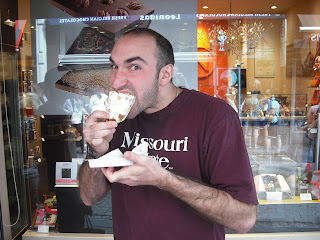 |
| The landscape view from my home |
I'm living in the guest house with two other volunteers. Both volunteers are leaving in mid-September, but luckily a new long-term volunteer is arriving next week. The guest house employs two cooks that slave over coal stoves all day to feed the volunteers and staff. The rooms are modest for western standards but comfortable for this area. Each room has two bunk beds (although I have my own room) and an eco-toilet with a hole in the ground for bucket showers. A few homes in the village have solar panels that provide limited power for charging appliances and for light at night. The guest house does have a solar panel which is nice at night. Each evening the lights go out whenever the solar energy is exhausted. On cloudy days, the lights go out early. The administration building has solar power and the clinic has running water, solar energy, and a generator for reliable electricity. These amenities are luxuries for the area. The village does not possess a refrigerator or freezer so dairy products such as cheese are also a luxury.
 |
| The guest house with my shadow in the picture |
Meals include are variation of beans, rice, ugali, maze corn, greens, tomatoes, potatoes, and bread. Meat is served in small quantities twice a week. Tea is served four times a day. The milk mixed with the tea is my main calcium staple. All foods are heavy and filling. The food is flavorful, although my taste buds are quickly satisfied due to the heavy starches and familiar tastes in each dish. Last weekend I bought some peanut butter and honey in the city of Kitui in order to add some sweetness to my starchy diet (it was a treat). Kitui is a city about 20 miles away from the village that has basically everything you need, including cold soda.
 |
| The eco-toilet |
The clinic provides medication and treatment for HIV and many other ailments. It also offers confidential HIV testing for people outside of the village and counseling for the village children affected by abuse or HIV. HIV+ children that are too young to comprehend the magnitude of the virus are told to take the medication in order to grow big and strong. The truth will be explained when they are old enough to comprehend. The village clinic provides several services to the outside community because it possesses medical equipment found nowhere else in the area (including the city of Kitui).
The people speak Kikamba to each other. I am learning base words but normally have no idea what they are talking about. Luckily many of the younger residents speak English.
 |
| A party in the guest house |
The highlight of a normal weekend is going into Kitui to shop and buy a cold beverage. It takes about an hour to reach Kitui although the distance is only about 20 miles (due to bad roads and stopping every few minutes to pickup and drop off customers). A matatu is usually the best option for transport. These 70s style twelve passenger vans are everywhere and are very uncomfortable because they are often crammed with 18 or 19 passengers.
 |
| A basin for doing laundry |
Everything is extremely cheap for me and very expensive for Kenyans. The ride to Kitui costs 70 shillings or just under $1.00. This is expensive for most people in the area considering a normal wage for working in the fields is 100 shillings per day ($1.20). A meal at one of the three restaurants in Kitui cost about 250 shillings or $3.15.
 |
| The standard soccer ball which is made of trash and a rope |
People live a rough life here. Most people in this area work on farms and are physically warn down by many years of tough manual labor in the intense sun. Despite the poverty, the people are very happy, generous, and thankful. Because everyone has so little, all community members contribute money for events such as weddings, funerals, etc. Meals are a social event in which everyone sits together and socializes face-to-face (text free). The community provides a sense of support and comfort. Everyone appreciates the little things such as a quality meal or a nice beverage such as sangaria (which we made for a party and everyone devoured).
 |
| The main soccer field in the village |
 |
| The guard Jon and his new hat I gave him |
It has been somewhat difficult adapting to such a slow pace of life. I want to be accomplishing something and therefore find it tough to just hangout and wait up to an hour for someone to delegate a job to me. "African time" actually exists. It is not uncommon for someone to show up an hour late for a meeting. Keeping time is just not as important here.
Cell phones have made it to Kenya and everyone has one. All cell phones are pre-pay and text messaging is not that popular here because there is no such thing as unlimited texting.
 |
| Me enjoying the opportunity to milk a cow |










